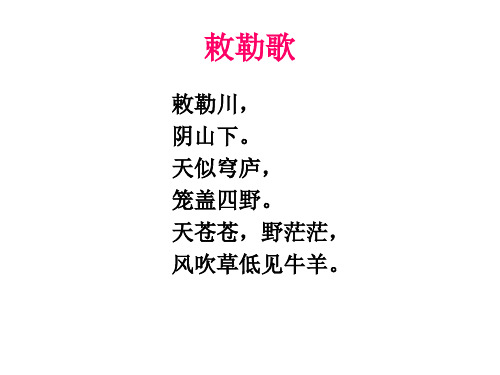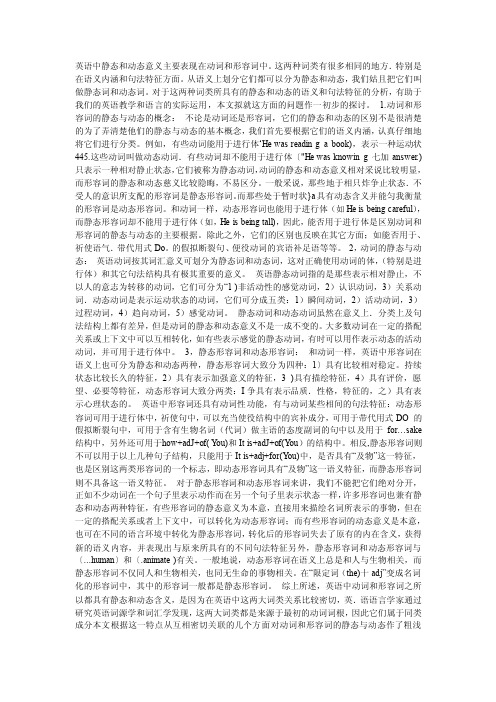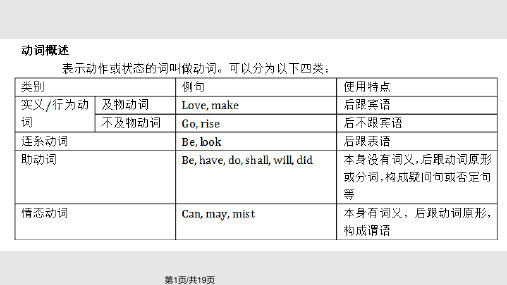静态动词与动态动词ppt课件
动静结合 PPT课件

——《紫藤萝瀑布》
清晨,江面上格外平静,碧波荡漾,银光闪烁,海
鸥在江面上展翅飞翔。此时,我总爱伫立在江堤上向北 眺望吴淞口,那一望无际的江面,水天相连。一陈清风 拂来,猛吸一口新鲜空气,顿时令人心旷神怡。江堤边 的树林里,鸟儿清脆的叫声此起彼伏。一群老人在堤岸 边散步,打太极拳……当阳光撒满江面的时候,江面开 始沸腾了。你看,那大小船只来来往往,川流不息。机 帆船的马达声、大轮船的汽笛声,江浪的撞击声交织在 一起,奏响了一支雄壮的交响乐。“呜“的一声汽笛。 一艘万吨轮由远而近,所到之处涌起两排巨浪,呈八字 形,像两条白龙朝两面三刀岸滚来,浪花扑打在江边的 岩石滩上,溅起一簇簇白花……晚上,沸腾的江面恢复 了宁静。这时,停靠在码头上的万吨巨轮灯火辉煌,和 天上的繁星交相辉映,把船边的江水也映红了。江风阵 阵,迎面袭来,驱散了夏日的暑意。
动静组合
• 两个黄鹂鸣翠柳,一行白鹭上青天。
• 作者所刻画的画面中,“黄鹂”、“白鹭” 是动态的——一个在鸣叫——鸣,一个在 直上云天——上。而“翠柳”、“青天” 是两个不动的静物,在作者的笔下,动物 和静物有机地结合在一起,构成一个灵动、 唯美的意境,这种写作技巧,就是运用组 合方式,将动静结合起来。
化静为动
1、在景物描写中使用动感很强的动词。
• 夕阳落山不久,西方的天空,还燃烧着一片橘 红色的晚霞。 ——《海滨仲夏夜 》
这里由于使用了“燃烧”这个动感很强的动 词,从而使静态景物变成了动态。
2、色彩的变幻,赋予静景以动感。
• 于是阳光掠过,云海的银涛像镀了金,又像 着了火,烧成灰烬,不知去向,露出大地的
• 每当一排排波浪涌起的时候,那映照在浪 峰上的霞光又红又亮,就像一片片霍霍燃 烧的火焰,闪烁着,消失了。 ——《海滨仲夏夜 》
动态性动词和静态性动词

动态性动词和静态性动词动态性动词与静态性动词(1)Dynamic Verb and Static Verb英语动词按其是否可以用于进行时态的语义特征,可以分为动态性动词和静态性动词。
大量的动词是动态性的,可以用于进行时态。
有一些动词是静态性的,不能用于进行时态。
还有不少动词,兼有动态与静态两种特性,而其含义是不同的。
动态性动词与静态性动词的用法有四个不同之处:(1)动态性动词可用于进行时态,而静态性动词则不可。
这是两种动词最根本的区别,例如:1)John is writing to his father.(约翰正在给他的父亲写信。
)2)John resembles his father.(约翰长得像他的父亲。
)John is resembling his father.(Impossible)3)John is painting his house.(约翰正在油漆他的房子。
)4)John owns a house.(约翰拥有一所房子。
)John is owning a house.(Impossible)有些动词可兼作两类动词,但意思不同。
动词“hold”的句子主语是人,则作“握住”解,是个动态性动同;句子主语是处所,则作“容纳”解,是个静态性动词,例如:5)a.John is holding a ball in his hands.b.John has a ball in his hands.(约翰正用两手握住球。
)6)a.The bus holds 50 people.b.50 people can sit in the bus.(这辆公共汽车能坐五十人。
)动词have可兼作两种类型。
当作动态性动词用时,表示动作的发生或过程,相当于take,get,receive,eat,drink等词,可用于进行时态。
当作静态性动词用时,表示“拥有”的概念,相当于own,possess等词,没有进行时态,例如:7)a.I was having my coffee quietly.b.I was drinking my coffee quietly.(当时我正在默默地喝咖啡。
静态和动态动词

英语中静态和动态意义主要表现在动词和形容词中。
这两种词类有很多相同的地方.特别是在语义内涵和句法特征方面。
从语义上划分它们都可以分为静态和动态,我们姑且把它们叫做静态词和动态词。
对于这两种词类所具有的静态和动态的语义和句法特征的分析,有助于我们的英语教学和语言的实际运用,本文拟就这方面的问题作一初步的探讨。
1.动词和形容词的静态与动态的概念:不论是动词还是形容词,它们的静态和动态的区别不是很清楚的为了弄清楚他们的静态与动态的基本概念,我们首先要根据它们的语义内涵,认真仔细地将它们进行分类。
例如,有些动词能用于进行体…Hewasreading a book),表示一种运动状445.这些动词叫做动态动词.有些动词却不能用于进行体〔"He was knowing七加answ er.)只表示一种相对静止状态,它们被称为静态动词,动词的静态和动态意义相对采说比较明显,而形容词的静态和动态慈义比较隐晦,不易区分。
一般采说,那些地于相只炸争止状态.不受人的意识所支配的形容词是静态形容词。
而那些处于暂时状}a具有动态含义并能匀我衡量的形容词是动态形容词。
和动词一样,动态形容词也能用于进行体(如He is being careful),而静态形容词却不能用于进行体(如,He is being tall),因此,能否用于进行体是区别动词和形容词的静态与动态的主要根据。
除此之外,它们的区别也反映在其它方面;如能否用于、祈使语气.带代用式Do。
的假拟断裂句、便役动词的宾语补足语等等。
2,动词的静态与动态:英语动词按其词汇意义可划分为静态词和动态词,这对正确使用动词的体,(特别是进行体)和其它句法结构具有极其重要的意义。
英语静态动词指的是那些表示相对静止,不以人的意志为转移的动词,它们可分为“1)非活动性的感觉动词,2)认识动词,3)关系动词.动态动词是表示运动状态的动词,它们可分成五类:1)瞬间动词,2)活动动词,3)过程动词,4)趋向动词,5)感觉动词。
【英语语法】动词及其时态、语态PPT课件_OK

2)表示按计划安排过去将要发生的动作 • They were leaving for New York a few days later. • He was departing the next month.
40
3)与always, constantly, forever等连用, 表示某种感情色彩
26
3)某些非延续性动词,在现在完成时中,不能同表示一段时间的状语连用
• 常见的这类动词有:come, go, begin, start, become, leave, marry等
• 不可说 Harry has got married for six years.
• 可以说 Harry has been married for six
I have thought it over. 我已经考虑过这件事了。 I have been thinking it over.我一直在考虑这件事
33
五.一般过去时
(Simple Past) • 1. 构成:动词的过去式 • 2. 功能
34
1)表示过去某个特定时间或某一段时 间发生的动作或情况
23
三. 现在完成时
( Present Perfective)
• 1. 构成: have/has + -ed分词 • 2. 功能
24
1)表示说话时已经发生或尚未发生的 事态,着眼点在现在
• I’ve forgotten his telephone number. • He has been ill for a long time. • I haven’t seen the film.
playing
played
was /were had played playing
小学动词ppt课件(2024)

can/could
表示可能的推测,如“It
could
be
rainy
tomorrow.”(明天可能
会下雨。)
may/might
表示不太肯定的推测,如 “She might not come to the party.”(她可能 不来参加聚会。)
27
06
动词短语和固定搭配
Chapter
如“喜欢跑步”、“开始唱歌” 等,两个动词连用表示一个动作 接着另一个动作发生。
7
02
小学阶段常用动词
Chapter
2024/1/30
8
表示动作行为动词
走、坐、看、听、打、拿、批评 、宣传、保卫、学习(动作行为
动词)
踢、踹、叩、舔、哭、笑、打骂 、动弹(表示身体动作的动词)
进行、开始、停止、禁止(表示 动作变化的动词)
动词在句子中起着核心作用,能够表达主语的行为、动 作或状态。
动词的时态、语态和语气等变化能够表达不同的时间和 情感色彩。
2024/1/30
4
动词分类与举例
表示主语状态或特征的动词,如 是、有、变成等。
表示说话人对动作或状态的情感 或态度,如应该、必须、可能等 。
2024/1/30
实义动词 系动词 助动词
05
表示格言或警句中。
06
例如:Pride goes before a fall. 骄者必 败。
14
现在进行时及用法
习惯进行
表示长期的或重复性的动作,说 话时动作未必正在进行。
例如
Mr. Green is writing another
novel. 他在写另一部小说。(说 话时并未在写,只处于写作的状
动态动词与静态动词(Dynamic verbs and Stative verbs)

⒊
关系动词(Relational Verbs)如:belong, contain,
deserve, cost, need, require, involve 及短语动词 apply to, belong to, consist of, depend on, etc.它们只阐述一种 情况而非动作,所以通常不可用进行体。例如:All the historic sites here required to be rebuilt. The right of selling the lands belongs to the state. What we should do next depends on the coming new director.
⒉
情感动词 (Verbs of Perception and
Cognition),表达心理状态或主观情感的动 如,like, hate ,forget, wish, love, want, etc.这 类动词往往表示主语的态度或感情色彩而非 动作,所以不能用进行体。例如: What you want is also we hope. The people around her loved her deeply for her loved of the poor. What Chinese most desired now is a forever-long peace.
静态动词 : Being a verb that
describes a state rather than an action or event. 表示现在或过去存在的某种状 态,而非动作,这种动词显著的特 点就是它们一般不用进行体。因此, 能否用进行体关键在其词汇意义。
英语翻译静态与动态PPT教学课件

2020/12/10
2
▪ 一、英语是屈折语,汉语是非屈折语,相对而言, 英语语言形态丰富。在一定程度上说,词的形态 (及形式)变化是否过于繁复多变决定了词类优 势。英语动词形态变化繁复而稳定,这就使英语 动词的使用受形态的制约,而名词就没有这个问 题,因此名词在英语中占优势,名词的优势导致 了介词的伴随优势。
▪
▪
第十一 讲
▪
静态与动态
▪
▪
(Static vs Dynamic)
2020/12/10
1
▪ I.教学目的和要求: ▪ 1.掌握动态化特征在汉语中的具体表现 ▪ 2.掌握静态化特征在英语中的具体表现 ▪ II.教学重点与难点: ▪ 1.汉语动词的翻译 ▪ 2.英语介词的翻译 ▪ III.教学方法:教师讲授、学生练习 ▪ IV.课时:2学时 ▪ V.课的类型:讲授课 ▪
▪ 因此,在有些情况下,汉语动词并不是译成英语动 词,而是要遵循英语的这一修辞特点,进行必要的 词性转换,即动词向名词、介词等的转化,使译文 符合英语的句法规律,因而更加地道、更显文采。
2020/12/10
8
▪ (一)动词转换成名词 ▪ 汉语中动词占优势,英语中名词占优势。一个主
要原因就是汉语中缺少像英语中的“-ing”词尾 和抽象名词的词缀那样的抽象化手段, ▪ 1.他妹妹老是说谎。
2020/12/10
7
▪ 下面从“动态”与“静态”这一修辞差异入手来 探讨汉译英中汉语动词(不包括判断动词和能愿 动词)的处理。
▪ 一、单动词汉语句子中动词的处理
▪ “英语的静态修辞的实质是名词优势和介词优势, 而介词优势又是名词优势的必然结果。因为名词 与名词之间要借助介词来联结”(蒋坚松, 2002: 56)。
初中英语动词讲解PPT课件

13. A computer ______ think for itself, it must be told what to do. A. can’t B. couldn’t C. may not D. might not 14. -Could I borrow your dictionary? -Yes, of course you _______. A. might B. will C. can D. should 15. ___ I know your name? A. May B. Will C. Shall D. Must 16. I _____ like to know where you were born. A. s hall B. should C. do D. may 17. ______ you be happy! A. Might B. Must C. Wish
第9页/共19页
有些动词它们既可以用作实义动词,又可以用作连系 动词。另外be还可用作助动词。它们的用法不同,词 义和句型结构也有所不同。例 如: Look at the blackboard, please.请看黑板。 (look用作实义动词) He looks a little tired.他略显疲 倦。(look用作连系动词) They are at work.他们在工 作。(are用作连系动词) They are working.他们正在 工作。(are用作助动词,帮助构成现在进行时)
第1页/共19页
一、实义动词 ①及物动词与不及物动词 根据后面是否带宾语,行为 动词又可分为及物动词和不及物动词,及物动词。 Vt. vi . They study hard. I know them well. 注:有的 动词既可作及物动词,也可用作不及物动词。 如: She sings very well. She sang an English song j ust now. 英语里有不少实义动词可以兼作及物动词和 不及物动词。兼作及物动词和不及物动词时,____不 变。试 较: Shall I begin at once? She began working as a li
《动态和静态动词》课件

2 强调状态
静态动词强调状态。
例子
1 He runs every day.
他每天都跑步。
2 He is tired today.
他今天很累。
总结
1 动态动词和静态动词是英语中两种不同的动词类型。 2 动态动词强调动作,静态动词强调状态。 3 运用动态和静态动词能使表达更准确生动。
《动态和静态动词》PPT 课件
动态和静态动词是英语中两种不同的动词类型。动态动词强调动作,静态动 词强调状态。正确运用动态和静态动词可以使表达更加准确和生动。
什么是动态动词?
1 描述动作或事件
动态动词描述一个动作或 者事件。
2 具有时态功能
3 例子
可以用来构成一般现在时、 一般过去时、一般将来时 等时态。
run(跑)、eat(吃) 、play(玩)、dance( 跳舞)等
什么是静态动词?
1 描述状态、性质、感 2 不具有时态功能
3 例子
觉等
只有一般现在时和一般过
be(是)、seem(似乎
静态动词描述状态、性质、去时两种。)、appear(出现)、
感觉等。
feel(感觉)等
动态和静态动词的区别
1 强调动作
静态与动态翻译课件

2)Prepositional phrases used as connectives
e.g.
in case of 万一
for fear of 以免
in contrast with 与 …不同(bù tónɡ)
in search of 寻求
with regard to 关于
党的干部吃着粗茶淡饭,住着冰冷的窑洞,点着 昏暗的油灯,长时间地工作着。
On behalf of the organizing committee, I sincerely invite you to the conference on Western literature as an honored guest.
are beneath my notice. 对这样一个毫无教养的人口中之言,不值一理。
精品PPT
2. Prepositional phrases used as attributives
他是个脱离了低级趣味的人。 He is a man above vulgar interests. 他有人给他撑腰。 He has someone behind him. 我在读莎士比亚写的剧本。 I am reading a play by Shakespeare. 这个民有、民治(mín zhì)、民享的政府将永存于世。 The government of the people, by the people and
他邀请我去他家吃午饭(wǔfàn)。 He invited me to his house for lunch. 我们热烈欢迎你们参加这次研讨会。 We warmly welcome you to the seminar. 读书足以怡情,足以博彩,足以长才。 Studies serve for delight, for ornament and for ability.
英汉静态与动态对比 PPT课件

英语的限定动词只能做谓语,而汉语中的动词(包括动宾 词组、主谓词组等)无处不在,不仅做谓语,也可做主语,如 “理论联系实际是我们党的优良传统”, 宾语,如“鲁迅主张打落水狗”,
他对总统声明为保持其职位而决心奋斗表示钦佩。
英汉对比之静态与动态(Static vs Dynamic)
在汉语里,动词使用频率高,呈现一种动态特征。 而在英语里,名词和介词使用频率高,呈现一种静态。
从语法上看, 英语句子是以动词为中心的。但动词的 使用频率明显低于汉语句子。周志培对三个翻译材料 (邓小平《在武昌、深圳、珠海、上海等地的谈话要 点》及英译文、英国首相撒切尔夫人在中国欢迎宴会 上的讲话及汉译文、美国罗斯福总统第四任就职演说 及汉译文) 进行分析,得出结论: 英语动词在这三个 材料中所占比率分别为14 %、11 %和15 % , 而汉语 动词所占的比率为则33 %、24 %和25 %。
来回、指控、说说笑笑。英语句子动词没有重叠
和组合这样的用法, 相比而言英语的动词使用频 率就不如汉语。
原因探析
一. 英语句子是以谓语动词为中心呈辐射状 的结构, 句子的其他成分以主谓结构为基础扩 展而成。不过, 英语是形合语言, 动词有形态 限制, 使用起来相对不自由。而汉语是一种典 型的分析型语言, 没有严格意义上的语法形态 变化及动词形态要求,动词不ቤተ መጻሕፍቲ ባይዱ与其他成分在 形态上相照应, 使用起来自由灵活。 汉语的介词贫乏,完全没有分词,英语使用介词 分词之处,汉语均用动词。
英汉对比静态与动态(课堂PPT)

Dynamic-汉语
1.动词连用是汉语常见现象 2.动词(词组)可充当汉语句子的各种成分 3.汉语动词常常重复或重叠
21
静化动练习
1. Party officials worked long hour on meagre food, in old caves, by dim lamps.
党的干部吃着粗茶淡饭,住着寒冷的窑洞,点着昏暗的油灯,长时
破旧立新
Down with the old and up with the new.
13
静态Stative-英语
1.名词化Nominalization 2.施事名词Agentive nouns in place of verbs. 3.介词Preparation- Prominent 4.动词弱化Verbs-weaken 5.形容词与副词Ajectives and adverbs in place of verbs
10
4.静态- Verb- weaken
❖动词虚化: 把动词转化或派生成名词,置于虚化动词(have, make, take, do)之后做其宾语,如have a look, take a walk, make attempts, pay visits, do some damages, put up a proposal
3
1.静态-Nominalization
❖名词化主要指用名词(短语)来表达原来属于动词(短语)所表达的 信息,如用抽象名词来表达动作、行为、变化、状态等。
医生迅速到达,并非常仔细地检查了病人,因此病人很快就康复了。 The doctor arrived extremely quickly and examined the patient uncommonly carefully; the result was that he recovered very speedily. The doctor's extremely quick arrival and uncommonly careful examination of the patient brought about his very speedy recovery.
动态和静态动词PPT课件

编辑版pppt
16
She is looking at the picture.
编辑版pppt
5
编辑版pppt
6
编辑版pppt
7
编辑版pppt
8
编辑版pppt
9
编辑版pppt
10
编辑版pppt
11
编辑版pppt
12
编辑版pppt
13Leabharlann 编辑版pppt14
编辑版pppt
15
感谢亲观看此幻灯片,此课件部分内容来源于网络, 如有侵权请及时联系我们删除,谢谢配合!
动态动词------- 动态动词描述动作, 可用于一般 现在时和进行时.
He studies in a university.
He is studying in the classroom.
静态动词------静- 态动词描述状态, 一般不用进行时.
常见的静态动词:
1. 表达思维活动的动词
admit, agree, believe, know ,mean, realise
feel 觉得/ 感到
I feel tired.
They feel they need more tome. ( 认为 )
How are you feeling ?
taste
尝起来有…味 +adj. 尝
It tastes sweet ( good/ terrible )
He is tasting the soup.
need, be 4. 感官动词
feel, hear, look , seem, smell, sound, taste
I understand what you said. We agree with you.
- 1、下载文档前请自行甄别文档内容的完整性,平台不提供额外的编辑、内容补充、找答案等附加服务。
- 2、"仅部分预览"的文档,不可在线预览部分如存在完整性等问题,可反馈申请退款(可完整预览的文档不适用该条件!)。
- 3、如文档侵犯您的权益,请联系客服反馈,我们会尽快为您处理(人工客服工作时间:9:00-18:30)。
精选ppt
1
• 静态动词:
• 表示一种状态,通常用于非进行体;若用进行体, 语义不同.
• 1. be, have
• 2. 含有be和have 意义的词,如 apply to, belong to, differ from, cost, weight, measure, fit, hold, lack, resemble
ten minutes. / The rescue team are leaving for Qinghai tonight. • 4. 表示刚刚过去的动作:I don’t know what you’re talking about. • 5. 表示委婉的语气:I’m hoping that you can come. / I’m wondering if
动态动词与静态动词
• 动态动词: 1. 表示持续动作,可用于进行、非进行体:
talk, run, sleep, wait
• 2. 表示改变或方位移动,可用于进行、非 进行体:come, go, arrive, leave, reach,
turn, become, get, grow, change
• 3.表示短暂动作。但要注意,用于过去一般 时,表示一次性短暂动作;用于过去进行 时,表示该动作的重复
• 也用于一些习惯性的用法中:I declare the conference open. / I wish you all the best.
精选ppt
5
• 4. 用于将来时间:
• 1) I hope / I bet 后的分句中:I hope you have a good time (=I hope you will have a good time). / I bet it rains tomorrow (=I bet it will rainfeel, hear, see, smell, taste
• 4. 表心理或情感状态的动词:believe, assume, consider, detest, fear, know, like, love, mean, mind, notice, prefer, remember
精选ppt
2
• 静态动词用于进行体时,则成了动态动词, 意义有所不同: He’s being polite today.
• They were having a party.
• He is resembling his father.
• The chef is tasting the soup.
• Please be quiet. I’m thinking.
用,则表示说话人的一种厌烦、赞美等感情: • You’re always asking for money. / She is constantly helping his
fellow students. (当然也可以不带感情色彩) • 3. 表示按计划安排近期内即将发生的动作:The plane is taking off in
• 2) see to it / make sure / make certain 后的分句中:Make sure that the equipment is disconnected from the power.
• 3) If it rains tomorrow, I’ll … • 5. 表示过去时间:
精选ppt
7
现在进行体
• 1. 表说话时正在进行的动作: The policeman is disinterring the body. • 2. 表示现阶段正在进行的动作:I’m preparing for the examination
these days. • Note: 进行体与always, constantly, continually, for ever等 频度状语连
• 历史现在时:p. 127
精选ppt
6
一般过去时
• 1. 表示过去一次性或习惯性动作:p. 128
• 2. 表示现在和将来:
• 1)want, hope, think , wonder等几个动词用于过 去时可表示委婉语气:I wondered if you could spare me a few minutes. / I hoped you could come here. Suppose we lunched on porridge made with lean meat and preserved egg?
这类动词有hear, learn, tell, say, gather 等: I hear that a big shot is coming to our university.
• She tells me you’re entering for the competition / examination.
• 2) 用于某些固定结构中:I wish the Campus were not so far away from GZ. / It’s high time that you went to bed. / If only I had enough money now./ He looks as if he was ill. / He treats the children as if they were his own.
被动态
精选ppt
4
一般现在时
• 1. 表示不受时限的客观存在(真理、格言、科学 事实等)
• 2. 表示习惯性经常性的动作
• 3. 表示现时的状态和现在瞬间动作:What’s the matter with you? You look pale. / What do you think?
• 常用于体育的现场报道、戏法表演、操作演示的 解说词中(见教材)
• I’m hoping you can make an exception to the children.
精选ppt
3
动词的时、体、态
• 1. 两种时间:现在和过去 • 2.两种体:进行体和完成体 • 3. 结合: • 现在:一般,进行,完成,完成进行 • 过去:一般,进行,完成,完成进行 • 4. 语态:主动和被动; be型被动态和get型
